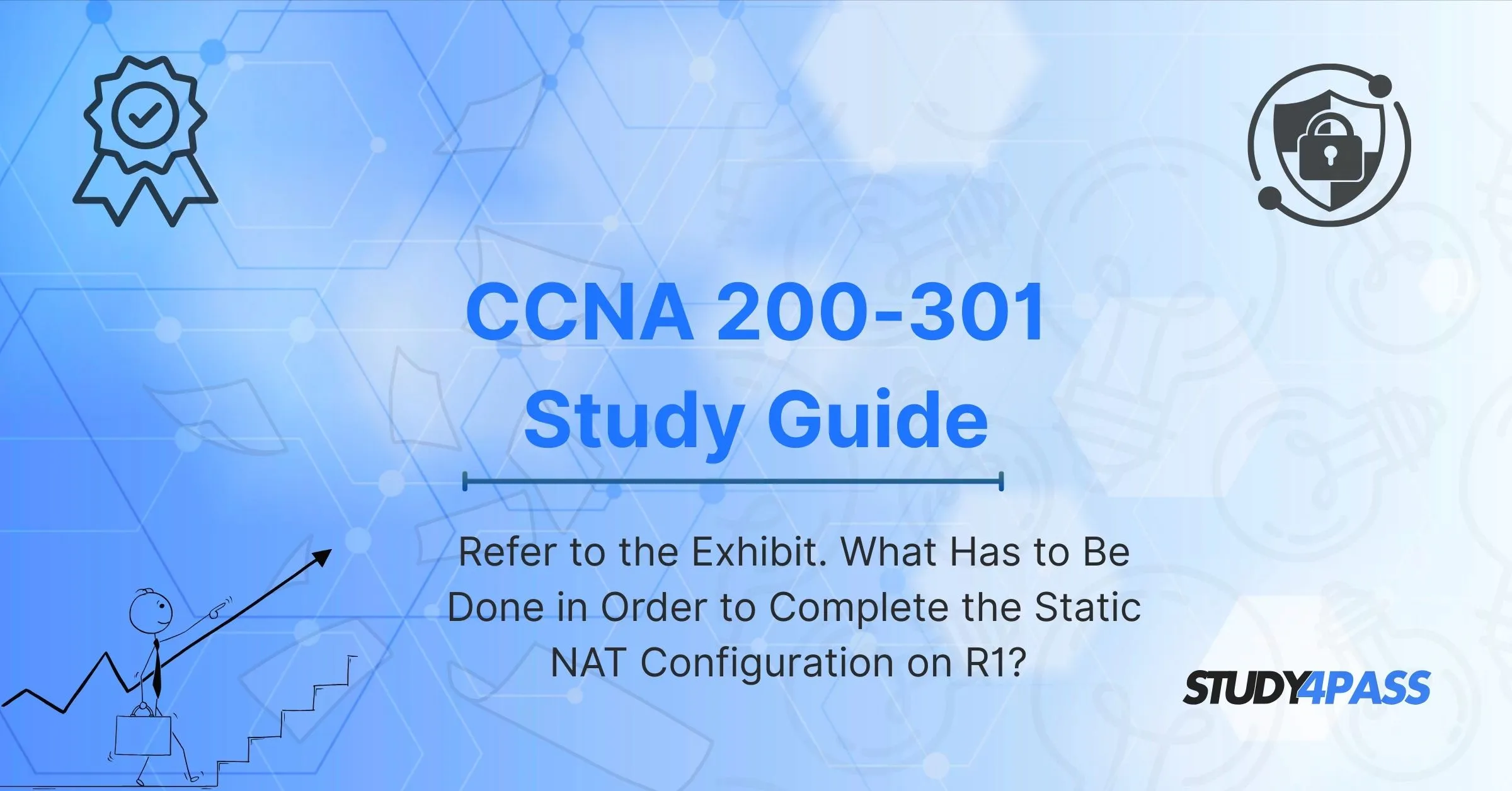Introduction To CCNA 200-301 Study Guide
Navigating the intricacies of Network Address Translation (NAT) is crucial for any aspiring network engineer. Especially when tackling the CCNA 200-301 exam, understanding static NAT configurations becomes paramount. Today, we'll dissect a common scenario often encountered in your CCNA 200-301 study guide, focusing on a typical "refer to the exhibit" question that tests your practical knowledge.
The Scenario: Static NAT on R1
Imagine you're presented with an exhibit showcasing a network topology, likely with R1 as a central router. The configuration aims to translate a specific internal IP address to a public IP address. The question asks, "What has to be done in order to complete the static NAT configuration on R1?" This type of question directly aligns with the CCNA 200-301 exam objectives, which emphasize practical configuration and troubleshooting skills.
Understanding Static NAT
Before diving into the solution, let's recap static NAT. It involves a one-to-one mapping between an internal (private) IP address and an external (public) IP address. This mapping is persistent, meaning the same public IP is always used for the same internal IP. Static NAT is commonly used for servers that need to be accessible from the internet.
Key Concepts for Your CCNA 200-301 Study Guide
To effectively answer this question, you need to grasp several core concepts:
- Inside Local Address: The private IP address within your local network.
- Inside Global Address: The public IP address used to represent the inside local address to the outside world.
- Outside Local Address: The private IP address of a device on the outside network, as seen from the inside.
- Outside Global Address: The public IP address of a device on the outside network.
- `ip nat inside source static` command: The primary command for configuring static NAT.
- Interface Configuration: Specifying which interfaces are "inside" and "outside."
Analyzing the Exhibit
- The exhibit will likely include:\
- R1's configuration snippets.
- Network topology diagram showing internal and external networks.
- IP addressing schemes.
Steps to Complete the Static NAT Configuration
1. Identify the Inside Local and Inside Global Addresses: The exhibit will provide the internal and external IP addresses involved in the translation. Determine which IP needs to be translated and what the corresponding public IP should be.
2. Configure the Static NAT Mapping: Using the `ip nat inside source static` command, map the inside local address to the inside global address. The syntax is:This command tells R1 to translate traffic from 192.168.1.10 to 203.0.113.1.
3. Designate Inside and Outside Interfaces: You must define which interfaces on R1 are "inside" (connected to the internal network) and "outside" (connected to the external network). Use the `ip nat inside` and `ip nat outside` commands on the respective interfaces. For example:
4. Verify the Configuration: Use the `show ip nat translations` command to verify that the static NAT translation is in place. You should see the mapping you configured.
Common CCNA 200-301 Pitfalls and How Study4Pass Can Help
- Incorrect Interface Configuration: Accidentally designating the wrong interfaces as inside or outside can lead to NAT not working.
- Overlapping IP Addresses: Using overlapping IP addresses can cause routing and NAT conflicts.
- Missing or Incorrect NAT Commands: Forgetting or mistyping the `ip nat inside source static` command will prevent the translation from occurring.
- Incorrect Routing: NAT relies on proper routing. If the router doesn’t know how to reach the destination, NAT won’t work.
How Study4Pass Enhances Your CCNA 200-301 Preparation
Study4Pass understands the importance of practical application. Our platform provides:
- Realistic Exam Simulations: We offer practice exams that mirror the actual CCNA 200-301 Certification, including "refer to the exhibit" questions and detailed explanations.
- In-Depth Study Guides: Our comprehensive study guides break down complex topics like NAT into easy-to-understand modules, ensuring you grasp the fundamentals.
- Hands-on Labs: We provide virtual lab environments where you can practice configuring and troubleshooting NAT scenarios, reinforcing your practical skills.
- Expert Support: Our team of certified instructors is available to answer your questions and provide guidance throughout your study journey.
- Up-to-Date Content: We continually update our materials to reflect the latest CCNA 200-301 exam objectives, ensuring you're always studying relevant content.
Why Choose Study4Pass?
- Proven Success: Our platform has helped countless students achieve their CCNA certifications.
- Affordable Pricing: We offer competitive pricing plans to fit your budget.
- User-Friendly Interface: Our platform is intuitive and easy to navigate, making your study experience seamless.
- Flexible Learning: Study4pass at your own pace and on your own schedule.
Conclusion
Mastering static NAT configuration is essential for success in the CCNA 200-301 exam. By understanding the core concepts, practicing with realistic scenarios, and utilizing resources like Study4Pass, you can confidently tackle any NAT-related question. Remember to focus on the commands and how they are used, and that proper Interface configuration is key.
Special Discount: Offer Valid For Limited Time “200-301 Exam Prep Practice Test”
Actual exam question from Cisco's 200-301 Exam.
Sample Questions for Cisco 200-301 Exam Prep Practice Tests
Which of the following is a characteristic of the TCP protocol?
A. Connectionless communication
B. Best-effort delivery
C. No acknowledgment
D. Reliable, connection-oriented communication
What command is used on a Cisco router to view directly connected networks?
A. show interfaces
B. show ip interface brief
C. show ip route
D. show version
Which IPv6 address type is used to send a packet to all interfaces in a group?
A. Unicast
B. Multicast
C. Anycast
D. Broadcast
What is the primary purpose of VLANs in a switched network?
A. To physically separate devices
B. To reduce the size of collision domains
C. To logically segment networks for improved efficiency and security
D. To route packets between different networks
What is the primary purpose of VLANs in a switched network?
A. To physically separate devices
B. To reduce the size of collision domains
C. To logically segment networks for improved efficiency and security
D. To route packets between different networks


